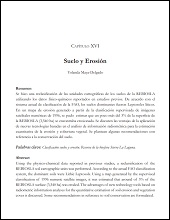El cardón Pachycereus pringlei, nuevo hospedero para Scyphophorus acupunctatus (Coleoptera: Curculionidae) en Baja California Sur, México
Autor
YOLANDA LOURDES MAYA DELGADO
CARLOS PALACIOS CARDIEL
MARIA LUISA JIMENEZ JIMENEZ
Metadatos
Mostrar el registro completo del ítemResumen
"Se presenta el primer registro de una cactácea, Pachycereus pringlei (cardón), especie dominante del matorral xerófilo de la península de Baja California, como hospedero de Scyphophorus acupunctatus (picudo del agave). A partir de observaciones y la recolección de individuos adultos y larvas, se pudo establecer que el picudo del agave causa al menos 3 tipos de daño al cardón: 1), barrenado en la región apical de los brazos por los adultos; 2), consumo de la médula de los brazos por las larvas, que puede ser tan extenso que ocasiona la muerte del cardón y 3), perforaciones en diversos sitios de los brazos, por donde las larvas eliminan los desechos, que pueden ser entrada de otros parásitos o que por lo menos dejan cicatrices en forma de tumor. El éxito de este insecto en el cardón podría representar una amenaza para las poblaciones naturales de esta cactácea e incluso para los servicios ambientales de los matorrales xerófilos." "This is the first record of a cactus, Pachycereus pringlei (giant cardon), which is a dominant species of the xerophyllous scrub in the Baja California peninsula, as a host of Scyphophorus acupunctatus (agave weevil). Based on observations and the sampling of adults and larvae, it was possible to establish that this weevil causes at least 3 types of damage to the cardon: 1), drilling of the tip of the branches by adults; 2), consumption of the branch medulla by larvae, which can be so extended that could cause the cardon’s death, and 3), perforations in the branches, used by larvae to eliminate wastes, that could serve as entrance to other pests and remain as tumor-like scars. The success that this insect seems to have by using the giant cardon cactus as host represents a threat to its natural populations and even to the xerophillous scrub environmental services."
Colecciones
Ítems relacionados
Mostrando ítems relacionados por Título, autor o materia.
-
PROMOCIÓN DEL PERIFITON PARA EL CULTIVO DE CAMARÓN BLANCO: HACIA UNA ACUICULTURA ECOLÓGICA
DOMENICO VOLTOLINA LOBINA; JUAN MANUEL AUDELO NARANJO; MARIA DEL ROSARIO PACHECO MARGES -
Suelo y Erosión
YOLANDA LOURDES MAYA DELGADO


